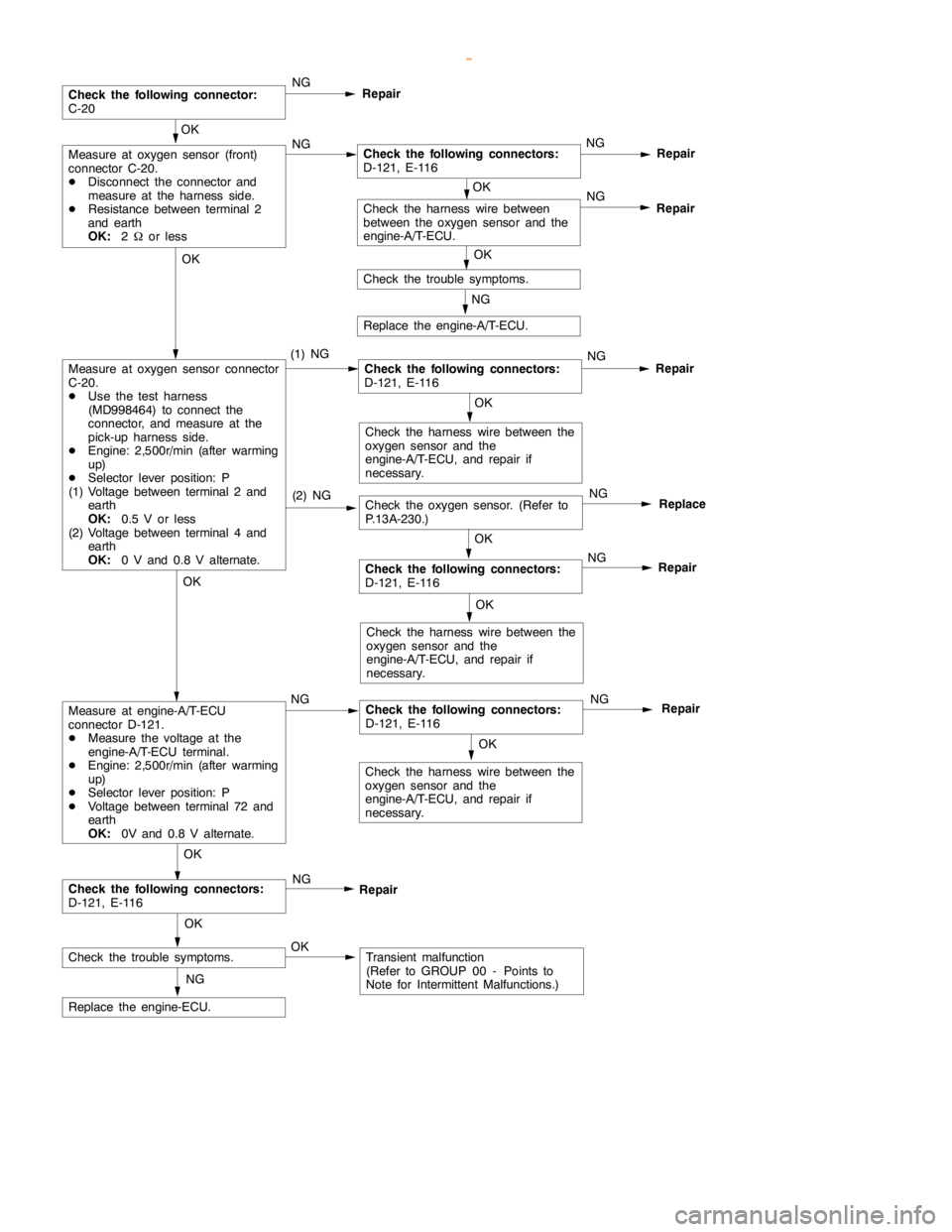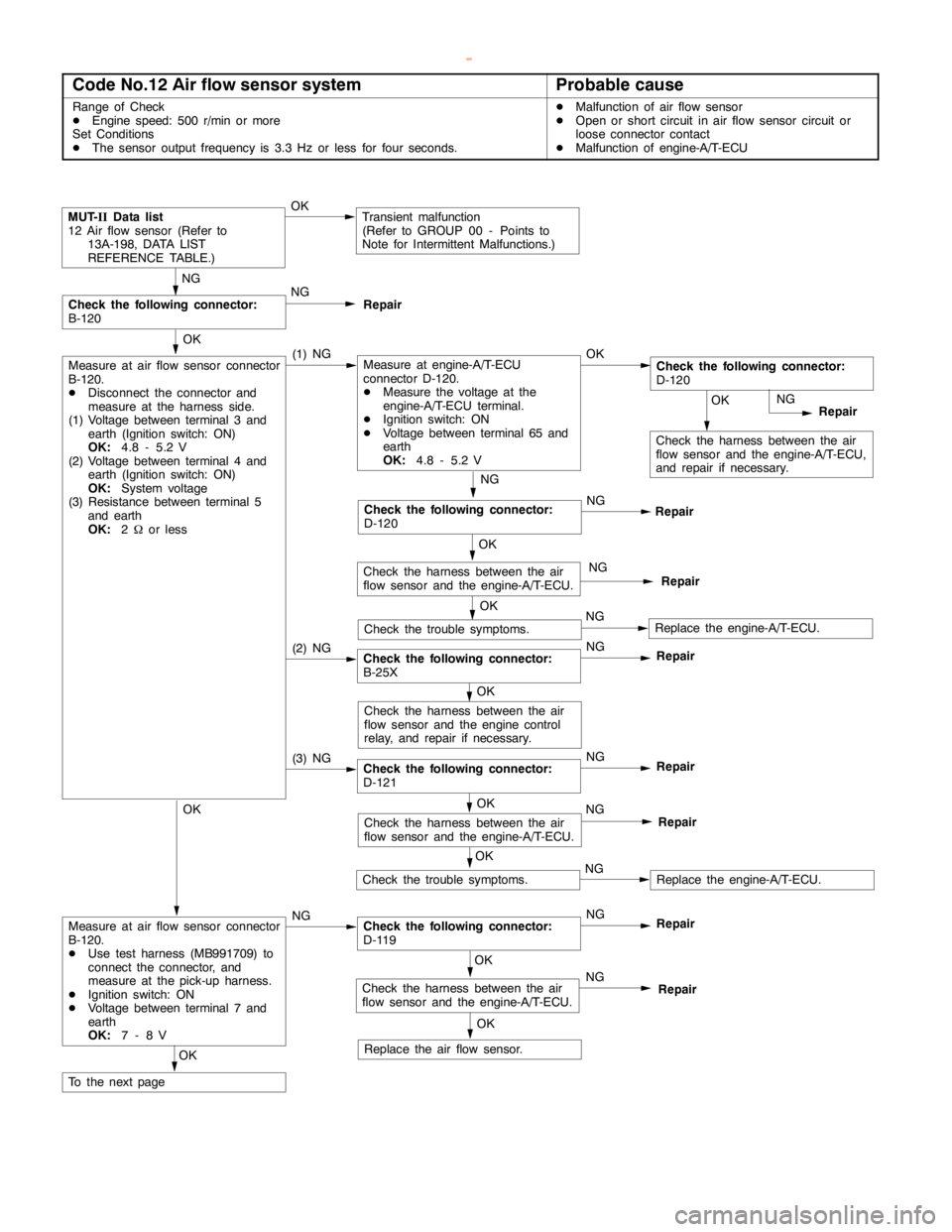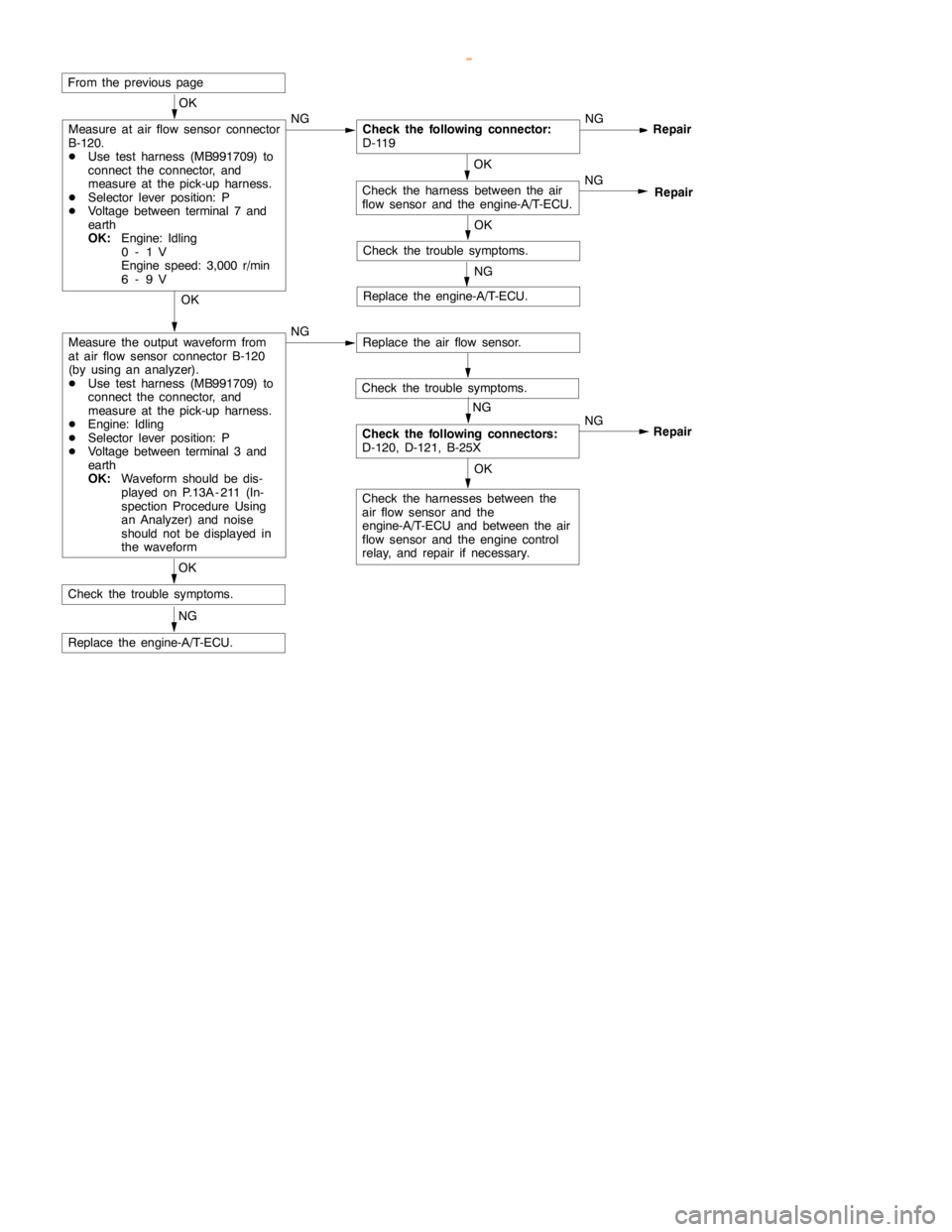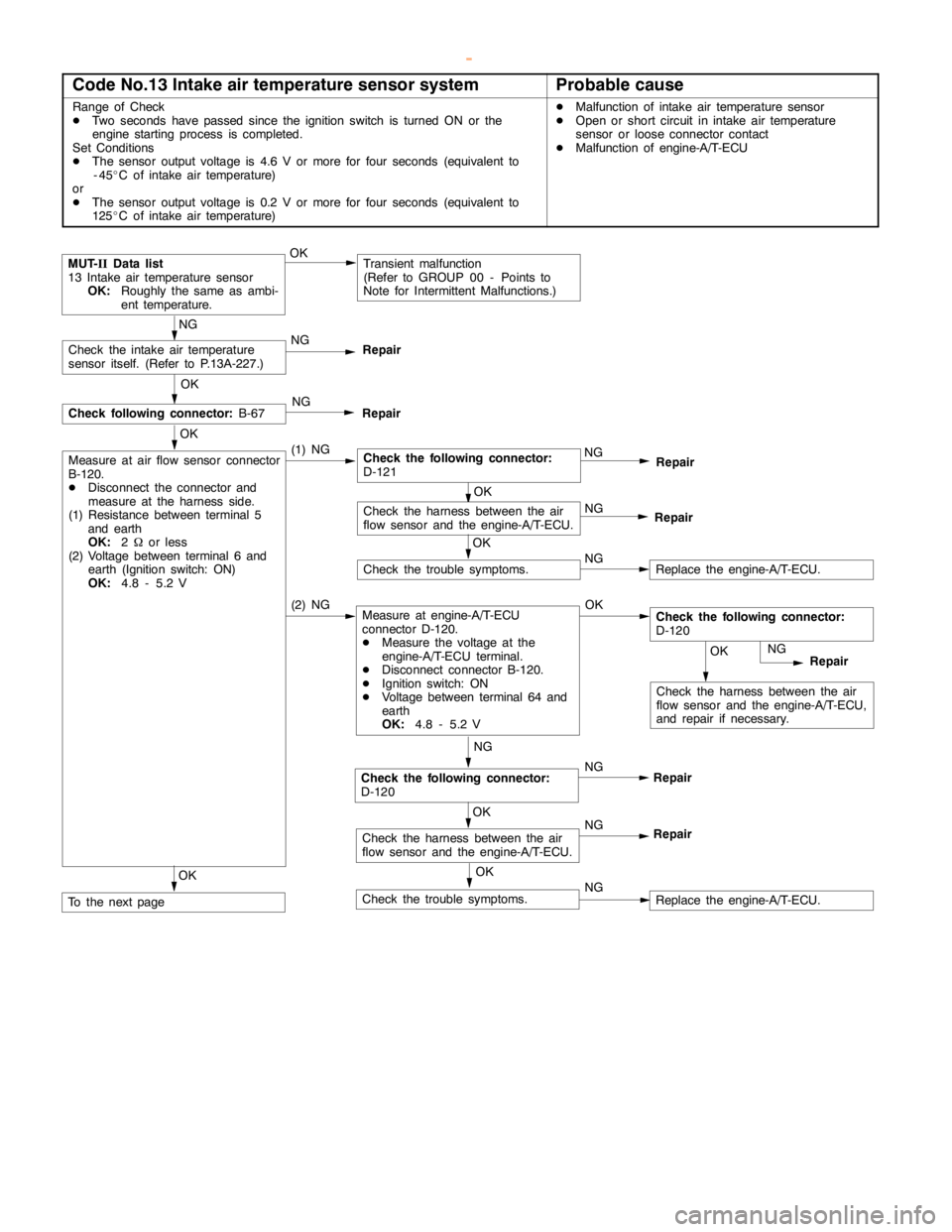2000 MITSUBISHI MONTERO check engine
[x] Cancel search: check enginePage 328 of 1839

GDI -Troubleshooting
Terminal
No.Normal condition Check requirements (engine condition) Check item
63Stop lamp switchDepress the brake pedal.System voltage
Release the brake pedal.0-3V
65A/C switch (2nd channel)Refer to GROUP 55 - Troubleshooting “Check at the A/C-ECU
terminal, engine-ECU output terminals.”
66Clutch switchDepress the clutch pedal.0-3V
Release the clutch pedal.System voltage
68Ignition switch-STEngine: Cranking8V or more
71Oxygen sensor (front)Engine: Warm up, and then hold the
engine speed at 2,500r/min (Use a
digital voltmeter).0«0.8 V alternates.
76Air flow sensor reset signalEngine: Idling0-1V
Engine: 3,000 r/min6-9V
78Throttle position sensor
(2nd channel)Ignition switch:
ONRelease the
accelerator pedal.4.5 - 5.5 V
Depress the
accelerator pedal
fully.0.4 - 0.6 V
79Accelerator pedal position
switchIgnition switch:
ONRelease the
accelerator pedal.0-1V
Depress the
accelerator pedal
fully.4V or more
80Vehicle speed sensorDIgnition switch: ON
DMove the vehicle forward.0«system voltage
alternates.
83A/C switch (1st channel)Engine: IdlingA/C switch: OFF0-3V
A/C switch: ON
(Compressor is
operating)System voltage
88Small lamp switchLighting switch: OFF0-3V
Lighting switch: ON (Taillamp: ON)System voltage
89Oxygen sensor heaterEngine: Idling0-3V
(front)
Engine: 3,500 r/minSystem voltage
90Oxygen sensor heaterEngine: Idling0-3V
(rear)
Engine: 3,500 r/minSystem voltage
92Fuel pressure sensorEngine: Idling0.3 - 4.7 V
www.WorkshopManuals.co.uk
Purchased from www.WorkshopManuals.co.uk
Page 329 of 1839

GDI -Troubleshooting
Terminal
No.Normal condition Check requirements (engine condition) Check item
94Accelerator pedal position
sensor (1st channel)Ignition switch:
ONRelease the acceler-
ator pedal.0.3 - 1.0 V*1
Depress the
accelerator pedal
fully.4.2 - 5.5 V*2
96Injector open circuit check
signalEngine: Increase engine speed from
idle speed to 4,000 r/min.Decreases slightly (approx.
0.7V) from 4.5 V - 5.0 V.
99Ignition switch - IGIgnition switch: ONSystem voltage
NOTE
Check if the difference in output between *1 and *2 is 4 V or more.
CHECK CHART FOR RESISTANCE AND CONTINUITY
BETWEEN TERMINALS
1. Turn the ignition switch to OFF.
2. Disconnect the engine-ECU connector.
3. Measure the resistance and check for continuity between
the terminals of the engine-ECU harness-side connector
while referring to the check chart.
NOTE
(1) When measuring resistance and checking continuity,
a harness for checking contact pin pressure should
be used instead of inserting a test probe.
(2) Checking need not be carried out in the order given
in the chart.
Caution
If the terminals that should be checked are mistaken,
or if connector terminals are not correctly shorted
to earth, damage may be caused to the vehicle wiring,
sensors, engine-ECU and/or ohmmeter.
Be careful to prevent this!
4. If the ohmmeter shows any deviation from the standard
value, check the corresponding sensor, actuator and
related electrical wiring, and then repair or replace.
5. After repair or replacement, recheck with the ohmmeter
to confirm that the repair or replacement has corrected
the problem.
www.WorkshopManuals.co.uk
Purchased from www.WorkshopManuals.co.uk
Page 341 of 1839

Page 345 of 1839

Page 346 of 1839

Page 347 of 1839

Page 348 of 1839

Page 349 of 1839

GDI -Troubleshooting13A-135
Code No.13 Intake air temperature sensor systemProbable cause
Range of Check
DTwo seconds have passed since the ignition switch is turned ON or the
engine startingprocess is completed.
Set Conditions
DThe sensor output voltage is 4.6 V or more for four seconds (equivalent to
-45_C of intake air temperature)
or
DThe sensor output voltage is 0.2 V or more for four seconds (equivalent to
125_C of intake air temperature)DMalfunction of intake air temperature sensor
DOpen or short circuit in intake air temperature
sensor or loose connector contact
DMalfunction of engine-A/T-ECU
OK
Check the harness between the air
flow sensor and the engine-A/T-ECU,
and repair if necessary.
MUT-
IIData list
13 Intake air temperature sensor
OK:
Roughly the same as ambi-
ent temperature.OKTransient malfunction
(Refer to GROUP 00 - Points to
Note for Intermittent Malfunctions.)
NG
Check the intake air temperature
sensor itself. (Refer to P.13A-227.)NG
Repair
OK
Measure at air flow sensor connector
B-120.
DDisconnect the connector and
measure at the harness side.
(1) Resistance between terminal 5
and earth
OK:
2Wor less
(2) Voltage between terminal 6 and
earth (Ignition switch: ON)
OK:
4.8 - 5.2 V(1) NG
NGRepair
NG
Repair
NG
Check the following connector:
D-120NG
Repair
OK
Check the harness between the air
flow sensor and the engine-A/T-ECU.NG
Repair
OK
Check the trouble symptoms.NGReplace the engine-A/T-ECU.
OK
Check following connector:
B-67NG
Repair
(2) NGMeasure at engine-A/T-ECU
connector D-120.
DMeasure the voltage at the
engine-A/T-ECU terminal.
DDisconnect connector B-120.
DIgnition switch: ON
DVoltage between terminal 64 and
earth
OK:
4.8 - 5.2 VOKCheck the following connector:
D-120
OK
Check the harness between the air
flow sensor and the engine-A/T-ECU.NG
Repair
OK
Check the trouble symptoms.NGReplace the engine-A/T-ECU.
OK
To the nextpage
Check the following connector:
D-121
www.WorkshopManuals.co.uk
Purchased from www.WorkshopManuals.co.uk